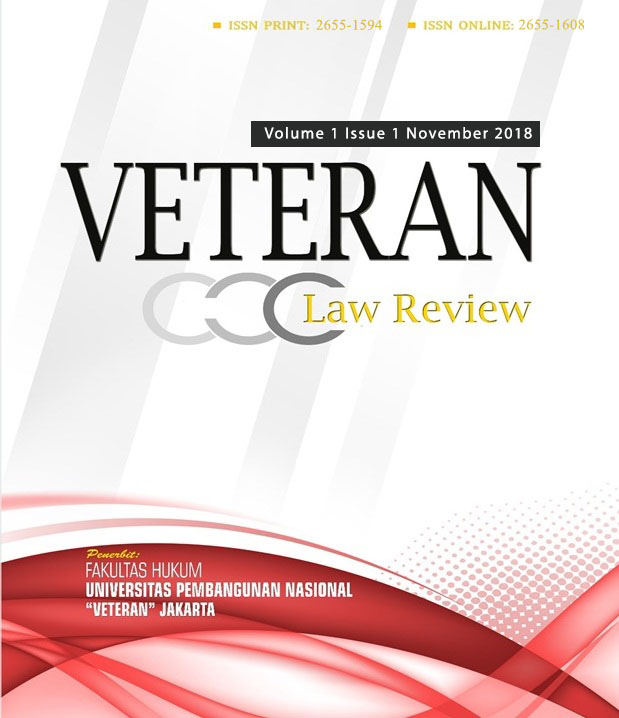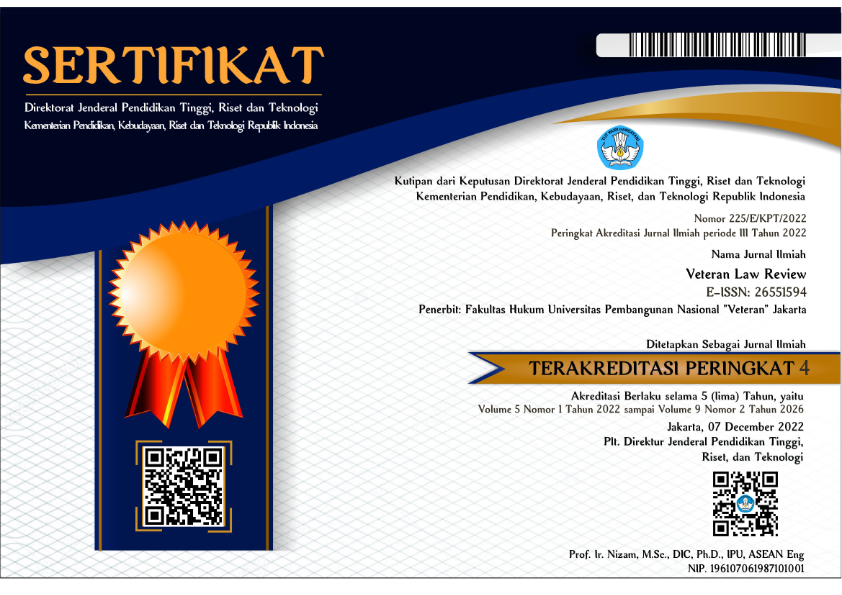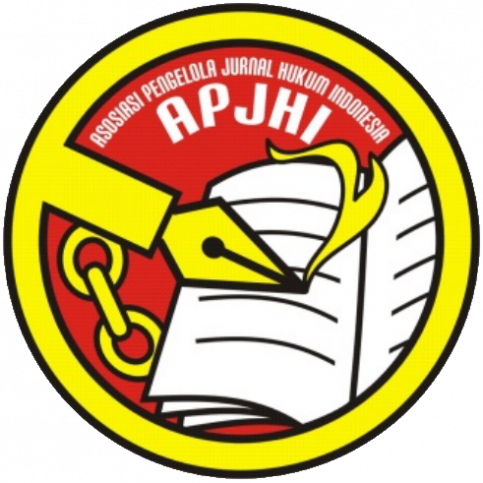Indonesia’s Criminal Law Policy On The Victim Of Narcotics Abuse In The Perspective Of Victimology
DOI:
https://doi.org/10.35586/velrev.v1i1.391Abstract
The design constructed by the formulation in the Law No. 35 of 2009 concerning Narcotics is that addicts and victims of narcotics abuse are given punitive measures (i.e. medical rehabilitation and social rehabilitation), whereas non-addicted narcotics abuse is given a criminal penalty. Parameters of narcotic abuse victims in the Law No. 35 of 2009 are very restricted and they are difficult to prove. Therefore, in addition to using the law, law enforcement officials also use other rules to determine the parameters of victims of drug abuse. The Law No. 35/2009, and also the law enforcement officers, uses the positivist victimology paradigm that places narcotics abusers as both perpetrators of crimes and victims of their own actions (self-victimizing victims). Meanwhile, according to radical victimology paradigm, narcotics abusers belong to precipitative victims. Based on that, this study recommend that the law formulation need to be made on the definition of drug abuse victims with the concept of depenalization, i.e. future criminal law policy includes narcotics abusers into victims who are required to undergo medical and social rehabilitation.Downloads
References
Arief, B. N. (2014). Bunga Rampai Kebijakan Hukum Pidana (Perkembangan Penyusunan Konsep KUHP Baru). Bandung: Citra Aditya Bakti.
Arief, B. N. (2014). Masalah Penegakan Hukum dan Kebijakan Penanggulangan Kejahatan. (Vols 4). Jakarta: Kencana.
Arrigo, B. A., & Thomas J. B. (1997). "Postmodern Criminology in Relation to Radical and Conflict Criminology". Critical Criminology. (Vols. 8, No. 2. Autumn 1997).
Badan Narkotika Nasional (BNN). (2017). “Hasil Survey Penyalahgunaan dan Peredaran Gelap Narkoba pada Kelompok Pelajar dan Mahasiswa di 18 Provinsi Tahun 2016”. BNN bekerjasama dengan Pusat Penelitian Kesehatan Universitas Indonesia, from http://www.bnn.go.id/_multimedia/document/2018050
/jurnal_data_puslitdatin_bnn_2017.pdf. accessed on December 12, 2017.
Bakhri, S. (2012). Kejahatan Narkotika dan Psikotropika: Suatu Pendekatan Melalui Kebijakan Hukum Pidana. Bekasi: Gramata Publishing.
Black, H. N. (1999). Black Law Dictionary. St. Paul Mn West Publishing, Co. Minnesota.
Dignan, J., (2005). “Chapter One: Victims, Victimization and Victimology”, dalam Understanding Victims and Restorative Justice. Open University Press, https://www.mheducation.co.uk/openup/chapters/0335209807.pdf.
Echols, J. M., & Sadili, H. (1996). Kamus Inggris – Indonesia. Jakarta: Gramedia.
Gosita, A. (2009). Masalah Korban Kejahatan: Kumpulan Karangan. Jakarta: Universitas Trisakti.
Gunarto, M. P. (2013). “Restrukturisasi Peradilan Pidana sebagai Upaya Mencegah Kelebihan Kapasitas Narapidana di Lembaga Pemasyarakatan”.
Inaugural Professorship Speech Paper at UGM Faculty of Law, delivered in front of the Open Senate Meeting of the Council of Professors of Gajah Mada University. Yogyakarta. December 24, 2013.
Irawan, Y. K. (2017). “Fidelis Divonis 8 Bulan Penjara dan Denda Rp 1 Miliar”. Kompas.com, https://regional.kompas.com/read/2017/08/02/11564981/ fidelis-divonis-8-bulan-penjara-dan-denda-rp-1-miliar. accessed on May 30, 2018.
Iskandar, A. (2015). Jalan Lurus Penanganan Penyalah Guna Narkotika dalam Konstruksi Hukum Positif. Karawang: Tanpas Communications.
Koentjoro. (2015). “Pencegahan Penyalahgunaan Narkoba di Kalangan Pelajar dan Mahasiswa”. in Sri Suryawati, Derajad S. Widhyaharto, and
Koentjoro (eds.), 2015. UGM Mengajak Raih Prestasi Tanpa Narkoba. Yogyakarta: Gadjah Mada University Press.
Mansur, D. M. A., & Gultom, E. (2008). Urgensi Perlindungan Korban Kejahatan: Antara Norma dan Realita. Jakarta: Raja Grafindo Persada.
Mardani. (2008). Penyalahgunaan Narkoba dalam Perspektif Hukum Islam dan Hukum Pidana Nasional. Jakarta: Raja Grafindo.
Merriam-Webster Dictionary Online, https://www.merriamwebster.com/dictionary
Muladi. (1995). Kapita Selekta Sistem Peradilan Pidana, Semarang: Badan Penerbit Universitas Diponegoro.
Mustofa, M. (2016). “Viktimologi Postmodern”, Simposium Nasional dan Pelatihan Hukum Pidana dan Kriminologi Ke-III. Banjarmasin: Fakultas Hukum Universitas Lambungmangkurat.
Najih, M. (2014). Politik Hukum Pidana: Konsepsi Pembaharuan Hukum Pidana dalam Cita Negara Hukum. Malang: Setara Press.
Partodiharjo, S. (2007). Kenali Narkoba dan Musuhi Penyalahgunaannya. Jakarta: Esensi.
Sahetapy, J. E. (1987). Viktimologi Sebuah Bunga Rampai. Jakarta: Pustaka Sinar Harapan.
Sholehuddin, M. (2003). Sistem Sanksi dalam Hukum Pidana: Ide Dasar Double Track System & Implementasinya. Jakarta: Raja Grafindo Persada..
Sujono, A. R., & Daniel, B. (2011). Komentar dan Pembahasan Undang-Undang Nomor 35 Tahun 2009 tentang Narkotika.(Vols. 1). Jakarta: Sinar Grafika.
Wilson, J. K. (2009). The Praeger Handbook of Victimology. California: ABC-CLIO.
Wolhuter, L., Olley, N., & Denham, D. (2009). Victimology: Victimisation and Victims’ Rights. New York: Routledge-Cavendish.
Yulia, R (2010). Viktimologi Perlindungan Hukum Terhadap Korban Kejahatan. Yogyakarta: Graha Ilmu.
Zikrie, I. “Korban Narkoba Seharusnya Tidak Dijebloskan ke Penjara”, CNN Indonesia, http://www.cnnindonesia.com/nasional/20150516160000-12-53598/ korban-narkoba-seharusnya-tidak-dijebloskan-ke-penjara, accessed on February 9, 2016.
Downloads
How to Cite
Issue
Section
License
Copyright (c) 2022 Veteran Law Review Journal
Veteran Law Review © 2022 by Faculty of Law Universitas Pembangunan Nasional "Veteran" Jakarta is licensed under Creative Commons Attribution 4.0 International

1. License
The non-commercial use of the article will be governed by the Creative Commons Attribution license as currently displayed on Creative Commons Attribution 4.0 International.
2. Author(s)' Warranties
The author warrants that the article is original, written by the stated author(s), has not been published before, contains no unlawful statements, does not infringe the rights of others, is subject to copyright that is vested exclusively in the author, and free of any third party rights, and that any necessary written permissions to quote from other sources have been obtained by the author(s).
3. User/Public Rights
VELREV's spirit is to disseminate articles published are as free as possible. Under the Creative Commons Attribution-ShareAlike 4.0 International License. VELREV permits users to copy, distribute, display, and perform the work for non-commercial purposes only. Users will also need to attribute authors and VELREV to distributing works in the journal and other media of publications.
4. Rights of Authors
Authors retain all their rights to the published works, such as (but not limited to) the following rights;
- Reproduce the work
- Prepare derivative works based upon the work
- Distribute copies of the work
- Perform the work publicly
- Display the work publicly
- Copyright and other proprietary rights relating to the article, such as patent rights,
- The right to self-archive the article,
- The right to enter into separate, additional contractual arrangements for the non-exclusive distribution of the article's published version (e.g., post it to an institutional repository or publish it in a book), with an acknowledgement of its initial publication in this journal (Veteran Law Review).
5. Co-Authorship
If the article was jointly prepared by more than one author, any author submitting the manuscript warrants that he/she has been authorized by all co-authors to be agreed on this copyright and license notice (agreement) on their behalf, and agrees to inform his/her co-authors of the terms of this policy. VELREV will not be held liable for anything that may arise due to the author's internal dispute. VELREV will only communicate with the corresponding author.
6. Royalties
Being an open accessed journal and disseminating articles for free under the Creative Commons license term mentioned, author(s) are aware that VELREV entitles the author(s) to no royalties or other fees.
7. Miscellaneous
VELREV will publish the article (or have it published) in the journal if the article’s editorial process is successfully completed. JOSI's editors may modify the article to a style of punctuation, spelling, capitalization, referencing, and usage that deems appropriate. The author acknowledges that the article may be published so that it will be publicly accessible and such access will be free of charge for the readers as mentioned in point 3.


















